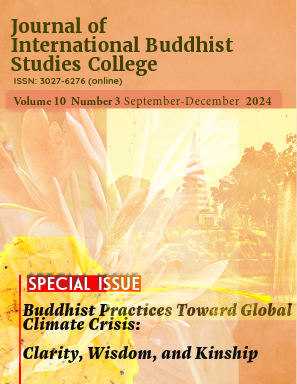THE Concept of the Mahāyāna’s Close Placement of Mindfulness on the Mind (Citta-smṛtyupasthāna) According to Bodhisattvacaryāvatāra
Main Article Content
Abstract
This study is about how to meditate on the Mahāyāna’s close placement of mindfulness on the mind (citta-smṛtyupasthāna) in daily life according to Bodhisattvacaryāvatāra. The practice focuses on understanding the mind’s nature—defined as the unity of cognition, luminosity, and emptiness—through the unification of conventional and ultimate truths. The objectives of the research are: 1) to study the concept of the Mahāyāna’s close placement of mindfulness (smṛtyupasthāna) according to Bodhisattvacaryāvatāra. 2) to observe the Mahāyāna’s close placement of mindfulness on the mind (citta-smṛtyupasthāna) according to Bodhisattvacaryāvatāra. 3) to apply the Mahāyāna’s close placement of mindfulness on the mind (citta-smṛtyupasthāna) in daily life according to Bodhisattvacaryāvatāra.
The data was obtained from the Bodhisattvacaryāvatāra and Mahāyāna’s scriptures, Commentaries and Sub-commentaries. As well as the secondary source of Buddhist textbooks, research works,dissertation, dictionary, newspaper, and journals respectively, together with the later interpretation from modern scholars, e.g., Yeshey Rinchen (H.E Leytsho Lopen of Bhutan) in Bhutanese languages, English languages, Sanskrit and Pali.
The research findings indicate that the practice aims for individuals to recognize the nature of the mind, and as a result, it encompasses various other practices. Wearing leather only on the soles of shoes is akin to covering the entire earth with it. Therefore, researchers opted for Mahāyāna’s emphasis on placing mindfulness on the mind (citta-smṛtyupasthāna) over other Buddhist spiritual traditions. Unlike other traditions where mindfulness meditation is seen as a means to avoid the defilements of the mind, Mahāyāna emphasizes a more integral connection with the mind. The study reveals that the Practicing Mahāyāna’s approach to mindfulness on the mind can lead to an understanding of the mind’s nature. This understanding, in turn, allows defilements to naturally fade away, revealing the true characteristics of the mind. In the absence of a polluted or defiled mind, societal problems diminish.
Article Details
The Journal of TCI is licensed under a Creative Commons Attribution-NonCommercial-NoDerivatives 4.0 International (CC BY-NC-ND 4.0) licence unless otherwise stated. Please read our Policies page for more information on Open Access, copyright and permissions.
References
Asaṅga. (1971). Abhidharmasamuccaya: The Compendium of the Higher Teaching, Philosophy. Fremont California: Asian Humanities Press.
Bhutanese Buddhist Calendar. (2021). Druk Phodrang Ding College of Astrology. Thimphu: Council for Religious Affairs Publication.
Binh. (2019). An Analysis on the Paths to Attaining Enlightenment in Theravada and Mahāyāna Buddhism. (Ph.D. dissertation). Graduate School, Mahachulalongkornrajavidylaya University.
Boyd, D. M., & Ellison, N. B. (2007). Social network sites: Definition, history, and scholarship. Journal of Computer-Mediated Communication, 13(1), 210-230.
Brynjolfsson, E., & McAfee, A. (2014). The second machine age: Work, progress, and prosperity in a time of brilliant technologies. W. W. Norton & Company.
Candrakīrti. (2012). Mādhyamakāvatāra. Boston: Shambala publication.
Chadwick, A. (2007). The hybrid media system: Politics and power. Oxford University Press.
Chadwick, A. (2013). The hybrid media system: Politics and power. Oxford University Press.
Enli, G., & Skogerbø, E. (2013). Social media and election campaigns in Norway: A comparative study. Nordicom Review, 34(2), 89-102.
Gampopa. (2002). The Jewel Ornament of Liberation, Delhi: Chos Spyod Publishcation.
Hibbing, J. R., & Theiss-Morse, E. (2002). Who votes? How voter composition affects the policies politicians pursue. Cambridge University Press.
Kabat-Zinn, J. (1994). Wherever you go, there you are: Mindfulness meditation in everyday life. Hyperion.
Kreiss, D. (2016). Prototype politics: Technology-intensive campaigning and the data of democracy. Oxford University Press.
Maitreyanāth. (2000). Mahāyāna Uttaratantra Śāstra. Translated by the Rosemarie Fuchs. New York: Snow Lion Publications.
McAfee, A., & Brynjolfsson, E. (2012). Big data: The management revolution. Harvard Business Review, 90(10), 60-68.
Meléndez, J., et al. (2020). Ethical considerations in the use of AI in local politics. Ethics and Information Technology, 22(3), 237-249.
Nāgārjuna. (1995). Mūlamadhyamakakārikā: The Fundamental Wisdom of the Middle Way. Translated by Jay L. Garfieid. Oxford University: Press.
Nāgārjuna. (2020). Precious Jewel Garland: Gyelpo la Gtam bay ba Rinpoche’i ‘phreng ba. Karnataka: Serajey Rigzodchenmoi Rtsom Sgrig Khang.
Namgyal. (2001). Mahāmudrā. New Delhi: Shri Jainendra Press.
Obhasa. (2019). An Analysis on the Meditation Techniques of Pa-Auk Sayadaw in the light of Satipaṭṭhāna. (Ph.D. dissertation). Graduate School, Mahachulalongkornrajavidylaya University.
Pew Research Center. (2019). The future of world religions: Population growth projections, 2010-2050. https://www.pewforum.org/2015/04/02/religious-projections-2010-2050/
Sanjib Kumar Das. (2014). Comprehensive Tri-Lingual Dictionary. New Delhi: Indraprastha Press.
Śāntideva. (2003). The Bodhicaryāvatāra (trans. K. Crosby & A. Skilton). Oxford University Press.
Śāntideva. (2014). Bodhisattvacaryāvatāra. Delhi-6: ABC Offset Printers.
Sunstein, C. R. (2007). Republic.com 2.0. Princeton University Press.
Thich Nhat Hanh. (1991). The miracle of mindfulness: An introduction to the practice of meditation. Beacon Press.
Vega-Mejía, L., et al. (2021). The psychological impact of augmented reality in political communication. Political Psychology, 42(1), 123-140.
Williams, P. (2009). Mahayana Buddhism: The doctrinal foundations. Routledge
Zangpo. (1974). The Thirty-seven Practices of Bodhisattvas. Phuentsholing: KMT Press.


